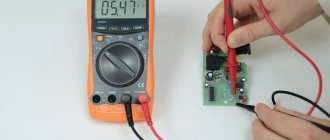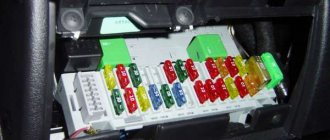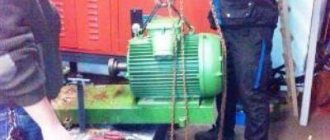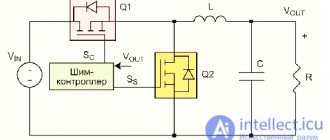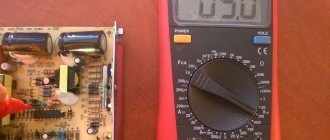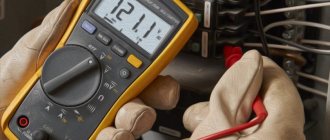A heating element is a tubular electric heating element that is installed in most modern heating household electric heaters that use electricity: on electric heating boilers, on a washing machine, on a water heater, on cooking stoves, on kettles and irons.
These heating elements are designed to last from 2 to 8 years, depending on the type of household appliance. The first indicator usually corresponds to an electric kettle, and the second to a washing machine. However, these terms can be significantly reduced due to improper operation of the heating element or manufacturing defects. After electrical heating equipment has ceased to perform its direct heating function, the first thing its owner needs to know is how to check the heating element with a multimeter.
What are the types of heating element malfunctions?
Malfunction of the heating element can be caused by several reasons:
- a burnt-out filament located inside the tube;
- life-threatening short circuit of a burnt wire connected to the device body;
- the formation of a thick layer of scale, which interferes with the heat transfer process and leads to overheating of the heating element.
How to check a water heater? First of all, you need to inspect it for any damage or cracks. A rupture of the heating element shell indicates poor quality of the part. If minor damage or roughness is found, the device cannot be repaired. It just needs to be replaced. If there is no visible damage, a ring is made using a multimeter.
Where is it located?
Placed inside the drum tank, the boiler is most often located as low as possible. This will allow the water to heat up extremely quickly. The power of the boiler reaches two kilowatts - almost like a powerful electric kettle.
To find the heating element, use the following methods.
- Check the area behind the back of the washing machine. The rear wall, characterized by a large area, hides the boiler behind itself. This wall is easier to remove than the others (front, top, bottom and side). If there are no boiler leads or wires going to it, you can easily close the lid at this point.
- It is permissible to tilt the SMA to one side and look towards the bottom.
- The drum hatch is large enough to open it and look inside the washing compartment. By turning on the flashlight, you can easily find the boiler. It may be closer to both the front panel and the rear wall.
Where is the water heating element located?
If we consider different brands of machines (Indesit, Bosch, LG), then the heating element in each type of model can be located in different places, and it is most convenient to approach it either through the back panel or through the front.
But if you are not aware of this, you can still find it yourself:
- The back panel of the machine is inspected. If the lid is large, then the heating device is located behind it;
- The machine must be placed on its side and the bottom inspected. This may be how you detect the heater;
- The easiest way is to remove the back panel. If there is no heating element there, then it will be easy to install it in its place.
There is another option - use a flashlight to illuminate the inside of the drum of the machine. If you have good vision, you can determine the exact location of the heater.
Having found the heating element, you need to make sure that it is working. Note that for such a procedure there is no need to dismantle the element.
Location of the water heater in the washing machine
The purpose of a large boiler is to raise the temperature of the water in the SMA tank to the desired hotness level. To achieve maximum heating effect, the heating element is located at the bottom of the washing machine.
For different models, access to the energy device is provided from the rear panel (Indesit, Ariston) or the front, like Bosch, Siemens. To understand where the heating element is located, proceed in the following sequence:
- Check the location under the rear wall of the case - it is easier to dismantle than the front panel. The heating element is determined by three terminals with wires extending from them.
- Tilt or place the car on its left or right side. If there is no bottom of the housing below, you can see the heater parts through the opening.
- Open the drum hatch and look through the holes in the perforated shell. With a flashlight, you can find the desired heating element.
Connecting an external heating element
Having understood which panel needs to be removed, they begin to dismantle it. When access to the heating device is provided, it is not necessary to immediately disassemble the circuit and remove the element: you can check the functionality on the spot.
What do you need to know before taking measurements?
If you have a multimeter, you can test the heater of a broken household appliance yourself.
But first you will need to find the technical data sheet of the faulty product and find out the nominal power value of its heater.
This is important, since to test the electric heater we will need to know the nominal value of its resistance, which is calculated from the formula of Ohm’s basic law:
R=U²/P,
where R is the desired electrical resistance (Ohm);
P – heating element power (W);
U – operating network voltage (V).
The operating voltage of the home electrical network is mainly 220 V. The power of the heater can be found from the passport data of the household device (W). The resistance value is obtained in Ohms. Now you can start testing the electric heater.
Expert advice
In order for the heating device to work as long as possible, you should provide proper care for the washing machine.
When performing repair work, be sure to disconnect the washing machine from the electrical network.
Many people recommend first removing the heater from the machine and then checking its functionality with instruments. But this is probably not necessary - the check can be easily carried out at the installation site. This will save time and avoid unnecessary work.
Checking the current leakage of the heating element
First of all, the search for the cause of the malfunction must begin with checking for current leakage. Usually, if this happens, immediately when connected to the network, the RCD or differential switch is triggered and the line is de-energized.
The leak search is performed as follows:
- Unplug the electrical appliance being tested from the outlet;
- We disassemble it to gain access to the electric heater terminals;
- Turn on the dial mode on the multimeter and insert the probes into the “COM” and “VMa” connectors;
- We first ring one contact on the device body, then the other;
- Possible results:
– There is a signal , the indicator on the display is close to “0” – the heating element is faulty;
– No signal , “1” on the display – no leakage;
Unfortunately, by calling in this way, you will not always be able to detect a breakdown. Quite often, this is detected only by a specialized tester - a megohmmeter, which tests circuits with high voltage. Minor insulation damage is detected only in this way. The multimeter will only detect obvious defects, for example, when the phase conductor touches the neutral conductor.
Often, a leak can be detected by measuring the heating element when it is turned on. But I don’t recommend doing this unless you are 100% confident in your electrical skills.
If you find a leak , a connection between one of the contacts and the housing, you need to look for the location of the breakdown. I advise you to disconnect the power wires from the electric heater and take measurements without them. Then you will understand whether the heating element or other elements of the power circuit are to blame.
RCD for water heater
An RCD is a special device that helps protect a water heater from current leaks.
The RCD looks like a small box with two lights and one button. The operating principle is as follows:
- The RCD is installed directly in front of the water heater itself; all the electric current passes through the RCD, which powers the boiler mechanism.
- As soon as a current leak occurs inside the boiler, which can become life-threatening, the RCD will detect the leak and turn off the entire system. The RCD operates using special sensors and switches.
What does an RCD look like?
Reasons for disconnecting the RCD:
- Incorrect location of the RCD. If the RCD is connected in the wrong place, then the system will conduct through itself the wrong electric current that is needed, so in the event of a breakdown, the system will not be able to protect a person from current leakage.
- The insulation of the heating element is damaged. This function protects the entire system from the passage of current through water. In old or unknown cheap models, this element can be damaged, so even with normal hand washing a person can receive an electric shock.
- Leakage current. A common reason for tripping the RCD is a broken cable or any other wire inside the boiler. In frequent cases, the cable is damaged from the inside, so the current is transferred to the boiler body, and since it is metal, the shock can be very strong when touched. In this case, you will have to check it from the inside.
It is important to install the RCD correctly, because it is what saves you from fires, explosions and other various situations that can harm others
How to ring a heating element for an open or short circuit
To check the heating element, you must first calculate its resistance using the power value P. Its value can be found in the technical documentation. The voltage U in the network is taken equal to 220 V. Resistance R is calculated using the well-known formula: R = U2/P.
The check is carried out according to the following algorithm:
- set the multimeter to a resistance range of up to 200 Ohms;
- touch the wires of the measuring device to the terminals of the heating element;
- if it is in good condition, it will show a resistance value close to the calculated value;
- the value “0” indicates the presence of a short circuit inside the heating element;
- value “1” – indicates an existing break.
At the next stage, the presence of a breakdown of the heating element to the housing is checked:
- the tester switches to sound mode;
- one of its wires touches the output of the heating element, and the second - its body;
- the appearance of a sound signal indicates a breakdown of the housing, that is, it is necessary to replace the heating element in the water heater.
We call the device
Before checking the serviceability of the heating element, the washing machine must be disconnected from the electrical network. After this, the wiring is disconnected, the tester switch is set to 200 Ohms, and its probes are applied to the water heater terminals.
The result of your actions will be:
- a functional element will display on the device screen a value close to the calculated value;
- if the tester displays “one”, then there is a break inside and the heater will have to be replaced;
- when the value is “zero” or close to it, a short circuit has occurred. Ten is not suitable for further work.
How is the resistance indicator of the heating element determined?
To check an element, it is not enough to know how and with what instruments this is done. It is necessary to have information about the value of its resistance. To begin with, it is recommended to calculate this value. To do this you will need the following information:
- Voltage supplied to the water heating element. As a rule, this indicator (U) is equal to 220 V. This voltage is present in the household electrical network of our apartments.
- The heater power indicator is R. It can be easily determined, you just need to look at the operating instructions. The second option - the power of the heating element can be checked on the Internet based on the model of the machine.
Having all the necessary information, we determine the resistance R using the special formula R=U²/P. The resulting resistance indicator is formed in the heater during operation. If the heating element is working properly, then the figure obtained by the formula will appear on the multimeter screen.
Finding heating element in the washing machine
First you need to find a heater. But before doing this, be sure to turn off the power from the outlet.
In many models (Indesit, Lg and Ariston) the heating element is located at the back , and only in Bosch and Siemens - at the front. If there is a large lid on the back of the washing machine, screwed on with hardware, then it is probably there. To get to it, just unscrew the bolts and remove the cover.
Another way to determine the location of the heating element is to look into the machine from below, carefully turning it on its side.
Calculation example
So, for example, when measuring you got a result of 20 ohms. Substituting into the formula, we calculate:
P, W Heating element power = 2202 V household voltage squared / 20 Ohm resistance of the heating element = 2,420 W
Accordingly, the power of the heating element that we tested is 2420 W, which fully corresponds to the declared indicator in the passport. And considering that it passed all other tests successfully, it means that the problem is not in it and you need to look further, for example, ring the electrical circuits or measure the voltage in the socket.
If the multimeter shows a result of 100 Ohms, then the power will be only about 500W. This is naturally not enough for normal operation and full heating of water. An increase in resistance can be caused by various processes: a decrease in the cross-section of the conductor, oxidation or contamination of contacts, etc. In any case, such a measurement will give you the necessary information for further search for causes.
As you can see, checking the operation of the heating element is quite simple; for this you only need a multimeter and a little free time. Many problems will be revealed by a simple test, and if this does not help, then by measuring the resistance parameters of the heating device.
And if you encounter any problem not described here, want to add something or find an error, write in the comments, it will be useful to many.
Checking for breakdown
Even if the heating element spiral is in perfect order, this does not mean that everything is normal. Perhaps the dielectric inside has leaked into the body of the washing machine, and this already poses a danger to your body.
To organize a test of the heating element for breakdown, set the tester to the “buzzer” mode. After connecting the wires, the lamp on the device should light up and a squeaking sound should be heard.
Now we use the tester to take the heating element terminal and apply the second probe to the body. If there is no squeak, then everything is in perfect order. Otherwise, the heating device will definitely have to be replaced.
How and with what to ring the heating element?
You need to find out which side the heater is located on. Inspect the body of the washer. The large rear hatch probably hides a TEN behind it. In the publication “How to replace a heating element in a SM” we gave an example of placing an element in different models.
Once you get to the part, disconnect the power wires from the contacts. It is not necessary to dismantle the product for diagnostics.
How to check the heating element in a washing machine with a tester:
- Calculate the resistance of the part. It may differ for each manufacturer. To do this, take the operating voltage (220 V) and power (indicated in the manual). For example, the power is 1800 W. Make the calculation using the formula: R=220²/1800=26.8. It turns out that the normal resistance of the heating element should be 26.8 Ohms.
Checking the operation of the heating element of a washing machine with a multimeter is carried out as follows:
- Set the toggle switch to resistance detection.
- If the screen shows normal values (about 26.8), then the part is working.
- Number 1 on the screen indicates a broken spiral. The product cannot be repaired, only replacement is needed.
- A value of 0 means a short circuit.
Now you need to check for a breakdown in the housing.
Important! Failure of the dielectric can lead to sparking and fire of the machine.
Switch the tester's toggle switch to buzzer mode. Place one probe on the contact and the other on the ground. The buzzer beeping means a breakdown. The heater must be replaced.
When replacing a part, remember the heating element connection diagram. During the disassembly process, you can photograph the stages of work. Here is a detailed inspection video:
If you do not have a multimeter at hand, then it is better to contact a specialist. Without the device, diagnostics will not be possible.
Online diagnostics of a washing machine
If your machine stops washing or rinsing clothes normally, then some kind of malfunction or breakdown has occurred.
You can try to find the problem yourself. Run diagnostics
Select which operation your washing machine does not perform:
1. Doesn’t drain 2. Doesn’t rotate the drum 3. Doesn’t spin clothes 4. Noises, knocks, buzzes when spinning 5. Doesn’t turn on
Checking the operation of the drain pump Is the drain pump of the washing machine working? Yes No I don’t know << Back
Clogged hoses in the washing machine If the sound corresponds to the normal sound that has always been observed when the device is working, the cause is probably a clog.
Was there a blockage in the drain hose? Yes
<< Back
The drain pump does not work! If the sound matches the normal sound of the drain pump, it is recommended that you check the drain filter first.
After cleaning, does the drain pump work and does the washing machine drain water? Not really
<< Back
Operation of the drain pump The sound of the pump is usually immediately audible and noticeable. If there is no sound, the pump is not working. We are looking for how to separately enable the water drainage program. As a rule, this is a separate option. After the program has been turned on, the pump should start working in 1-3 seconds. If everything is done correctly and the pump is operational, a buzzing sound will appear. If you hear no buzzing or other sounds when you turn on the program, the pump is probably faulty.
Is the washing machine drain pump working? Not really
<< Back
Clogged car hoses If you have identified a clog in the hoses, you need to disassemble them, clean them, and then reassemble everything.
Does the washing machine drain well? Not really
<< Back
Hurray, you did a great job, you fixed it.
<< Return to the beginning of diagnostics
The drain pump is faulty, call a professional.
<< Return to the beginning of the diagnosis.
The washing machine does not rotate the drum. During the operation of the washing machine, such a problem may occur. Each model has a different drum operation. It rotates according to a given algorithm, which is set by the program. This principle applies to spinning and washing. If you are not sure whether the drum is not spinning or whether it is working, put the laundry in the washing machine. Start the spin program. If the machine is running, it will first drain the water and then start spinning. In this case, a rotational process will be observed. If rotation is not visible, then check the belt. First, turn off the program, then unplug the wire from the outlet so that power does not flow into the device. Now you need to remove the back cover. You will need to carefully inspect the drum belt. It is quite easy to determine whether it is in the wrong position or damaged.
Is the washing machine belt torn or stretched? Not really
<< Back
Broken drum drive belt If the belt breaks, it will be immediately visible. There are also often cases when the belt simply stretches, which is why the drum, accordingly, does not rotate. Do not allow the machine to operate if the belt breaks. It is important to check whether it has wound around the engine pulley or broken the wiring to the engine. The heating element and temperature sensor may also be damaged if the belt does catch the wires. It is imperative to ensure that the belt model is original. If you choose an unsuitable or low-quality product, this will affect the performance of other devices. How do you know what kind of belt you have? There will be a marking written on the old one, compare it with the one indicated on the belt offered to you. You can also find out belt information by car model.
<< Return to the beginning of the diagnosis.
Washing machine motor malfunction If a malfunction is not found, the block with wires must be disconnected from the electric motor. Carefully remove it. We visually evaluate the engine. It may have melting, cracks, or other effects that clearly indicate damage. We call the windings of the tachogenerator and the engine. It is important to understand that you can fully study how correctly the engine operates and whether there is a malfunction only at the stand. If rotation does not occur, there may be a problem with more than just the motor. Sometimes the cause is a malfunctioning electronic module. If a short circuit occurs in the engine, the module could be damaged, while the engine remains operational. Also, the wires could be damaged.
<< Return to the beginning of the diagnosis.
Repairing a washing machine that does not spin clothes After completing the washing process, the washing machine may not spin properly or may not start spinning. Firstly, look, perhaps another mode is set, which does not involve turning on the spin cycle at all. This happens, for example, with programs related to washing woolen items and delicate fabrics. To check, run the spin cycle separately. If the washing machine does not drain water, we proceed to check the pump.
Does the washing machine now spin clothes? Not really
<< Back
Congratulations, you have solved your problem!
<< Return to the beginning of the diagnosis.
Repair of washing machines, imbalance Modern washing machines place the laundry on the drum before spinning. This is necessary for quality work. Check if this feature works. Sometimes a situation occurs when things get wrapped up in a ball that cannot be unwound automatically within a certain time. At this point the work stops. You need to unwind this laundry yourself, lay it out and continue operating the washing machine. In this case, it is important to turn off the machine, and then, when the laundry is laid out, turn on a separate spin program.
Does the washing machine now spin clothes? Not really
<< Back
Washing machine repair, drum drive repair Now you need to check the drum drive belt. We remove the cover and visually assess the condition of the belt. There should be no damage. If the tension is weak, the spin may not turn on. If you need to replace the belt, you should only replace it with the original one. After replacing, we try the program again.
Fault found, does the washing machine spin? Not really
<< Back
The engine or electronic module is faulty, call a repairman to your home.
<< Return to the beginning of the diagnosis.
The washing machine hums, makes noise during the spin cycle, rumbles, and makes a jet plane noise. If the washing machine makes noise during operation, making unusual sounds, it’s time to pay special attention to it. In this case, a visible breakdown or lack of functionality may not be observed, but the appearance of strange sounds indicates that it is time to look for a malfunction. It is important to understand that a new car that has just been delivered should be inspected for shipping bolts. If you forget to remove them, noise and vibration are inevitable. So, let's begin! We turn the washing machine drum and listen to extraneous sounds.
When rotating, do you hear extraneous noise, hum, balls rolling, does the drum move unevenly with slight jamming? Not really
<< Back
If the drum rotates and uncharacteristic sounds appear, including vibration, it’s time to check the bearings. If they malfunction, they will have to be replaced.
<< Return to the beginning of the diagnosis.
The counterweight of the washing machine has come loose. The fastening of the counterweights must also be of high quality. If they are “loose”, it’s time to eliminate this defect. In some cases, you can notice that the bolts that secure the stones are completely missing. In this case, the connectors for mounting will be visible. The bolts need to be found and put in place - they probably simply came loose. A rumble heard while the washing machine is operating may indicate that the bolts have partially loosened. To check the bolts, you can simply push the drum. If it is secure, the bolts are fine. If it moves, there is a defect.
Do you hear any noise, clanging or rattling noises when moving the washing machine tub? Not really
<< Back
The counterweight has come off
<< Return to the beginning of diagnostics
Checking the shock absorbers of the washing machine Checking the shock absorbers. If you hear vibration or excessive noise during the spin cycle, there may be a problem with the shock absorbers. Sometimes the washer moves. Now let's check the functionality. Remove the top cover. Click on the tank, move it five to seven centimeters down. A normal reaction will be observed if the tank rises sharply, jumping a little and stopping in its normal place. If this does not happen, the shock absorbers need to be replaced.
Are the shock absorbers of the washing machine working? Not really
<< Back
If a visible defect has not been identified, check whether a foreign object may have entered the machine. Replacing shock absorbers. The problem with shock absorbers wearing out occurs quite often over time.
<< Return to the beginning of the diagnosis.
Replacing washing machine shock absorbers. Malfunction and wear of shock absorbers is a fairly common phenomenon.
<< Return to the beginning of the diagnosis.
The washing machine does not turn on. It is worth trying to find the cause of the problem yourself and fix it. We start by connecting the device to the network. Next, click on the “network” button. In different car models, different indications are triggered: here either the display will start working, or, on the contrary, some other button.
Does the washing machine have an indicator? Not really
<< Back
Hatch lock lock (UBL) You can check it by turning on any of the programs. We choose what we will use. Click on the corresponding button. Don't forget to pay attention to the inclusion. As a rule, the process of activating a function is characterized by the presence of a certain sound, for example a click, with which the device makes it clear that pressing again is not necessary and the machine is already working. If there is no sound, the button may be broken. In this case, the main thing that must be done is to block the hatch and start working. If this happens, everything is fine.
The washing machine is blocking the hatch and the UBL is triggered? Not really
<< Back
Water fill valve malfunction
<< Return to the beginning of the diagnosis.
The washing machine hatch does not lock
<< Return to the beginning of the diagnosis.
No indication Checking the electrical circuit. If you notice that the washing machine does not respond to being turned on, it is first recommended to check the power supply. The outlet may be faulty. Try connecting another device. If the outlet works, you need to check whether the circuit that conducts energy through the washing machine from one element to another is intact. To do this, you will need a multimeter, which will help you fully analyze the ability to respond to an electrical signal at several stages of operation. If there is no network connection anywhere, this is probably the problem. We carry out this manipulation until we reach the electronic module. If we are talking about an old washing machine, here it will look like the device’s program. When you turn on the button, there should be no breaks in the circuit. If the circuit works, everything is fine electrically.
Is the washing machine's power supply OK? Not really
<< Back
Repair of electronic module (unit)
<< Return to the beginning of diagnostics
Contact circuit fault
<< Return to the beginning of diagnostics
Ringing a power consuming device
To check the integrity of the spiral inside the heating element, the supply wires are disconnected from the element. Before doing this, it is useful to note the order of connection to the terminals and capture the initial appearance in the photo. It is not necessary to remove the heater from the tank.
Multimeter
Tester test sequence:
- Set the switch to test resistance: up to 200 Ohms. Checking the serviceability of the multimeter - close the lead wires of the meter: zero will be displayed on the screen. Attach the probes of the device to the contacts.
- The normal range of scale readings is 20-50 Ohms. The boiler is in working order.
- Values ≥100 indicate a heater failure.
- Infinity is a break in the spiral. Zero – short circuit.
Expert opinion
I work in the household appliance repair industry. Extensive experience in restoring washing machines and dishwashers.
Ask a Question
Any deviations from the standard values of the coil resistance entail the need to replace the electric heater with a new one. Testing the element on the body should give a result close to infinity. If the device resistance is significantly less than 20 ohms, the heater is faulty.
Checking for breakdown
The space between the spiral and the inner walls of the tube is filled with dielectric powder made of mica, heat-resistant clay or quartz. Such an insulator protects the heater shell from contact with the spiral through which the electric current passes.
A breakdown test is carried out when electricity leaks occur in the washing machine on the metal parts of the body, and the RCD is triggered. Actions to determine a breakdown:
- The tester switches to buzzer mode. Checking the serviceability of the measuring device is carried out by shorting the output wires. At the same time, a light signal from the light bulb will appear and a sound will sound - a squeak. One probe is placed on any terminal of the heater, the other touches the metal shell of the heating element or the grounding contact.
- The absence of a signal sound will indicate that the element is working properly. Further operation of the boiler is permitted.
- A buzzer squeaking during a breakdown test is a sure sign of a breakdown of the electric heater.
Long-term use of a washing machine leads to physical aging of its parts, including the insulation inside the heater. Observe the decrease in the quality of the dielectric powder using a megohmmeter.
New water heater
Dialing methods
There are methods that allow you to evaluate the serviceability of the device if you do not have a multimeter at hand when problems are detected. They give a less accurate result than working with a digital meter, but it is quite possible to assess the need to replace a part with their help.
The simplest method to check the heating element on a water heater does not require the use of any tools. However, it will be necessary to remove the element from the heating device. The heating element must be carefully examined. If the assessment of the condition is hindered by accumulated scale, it is dissolved by soaking the part in water with vinegar or citric acid. It needs to be kept in acidified liquid for about 6 hours.
Scale deposits cause a number of common problems with equipment - because of them, the heating time of water increases, and the part itself, if not promptly cleaned, soon burns out.
If scratches, any deformations or dark spots are found on the heating element, it should definitely be replaced.
Using an indicator screwdriver on the battery is also allowed for checking. Before testing, be sure to disconnect the equipment from the current and disconnect all conductors from the heating element. The first terminal clamp is touched with a finger, and the tip of the tool is brought to the second supply clamp, touching the end contact. If the indicator lights up, the heater has not failed.
Heating elements are tested with special test lamps. This option is suitable for professional electricians or people who have sufficient experience in handling circuits. You can assemble the circuit yourself using a 220 V incandescent light bulb. It is screwed into a socket to which single-core copper wires are connected with probes screwed to them. The lamp is connected to the network between the device being tested and the power source. If it lights up, the unit is functioning normally. To check the heating device, a mains neutral is supplied to one of the contacts, and a phase wire with a connected lamp is supplied to the other.
Checking the heating element with a multimeter
To begin the testing process, you must first secure your work by disconnecting the household unit from the network. You just need to unplug the electrical power cord from the outlet, and for an electric kitchen stove with a separate line, perhaps turn off the circuit breakers in the apartment electrical panel. In any case, you need to turn off the power to the equipment.
It would be more correct to proceed according to the following algorithm.
- Provide access to the electrical heater terminals. It may be that in some cases the heating element will have to be completely removed from the unit for ease of testing.
- Disconnect the wires from the heater.
- If there is scale on the device, then it is necessary to clean the heating element from it.
- After this, carefully inspect the heater for cracks, swelling or other signs of damage.
- Prepare the tester (multimeter) by switching it to the electrical resistance measurement mode. The measurement range must be selected depending on the result obtained, which we calculated using the formula for the nominal resistance for the heater of our equipment.
What is the purpose of the inspection?
An electric iron or boiler is equipment that includes other devices that in one way or another affect the operation of the entire system. These devices also do not last forever, therefore, in the event of a malfunction of the equipment as a whole, the owner should not reduce the cause only to the failure of the heating element. Electric kettles are often thrown into the trash because they begin to heat the water slowly or turn off too often without bringing the water to a boil. This implies, of course, that the coil in the heating element has burned out, although it turns out that the reason is not in the electrical circuit of the unit, but in the thick layer of scale that covers the entire heater tube. All that was needed was to clean the heating element from the outside.
The check will allow you to find the exact reason why the heating element does not heat, and only then you can decide what to do about it.
To understand the verification process, you should know how the heating element works and works. Inside the tube, which is also the body of the device, made of metal, ceramics or glass, one or more spirals of a material with high resistance are laid. When the heating element is turned on, an electric current moves in a spiral, the spiral heats up to a high temperature and heats up the electrical insulating material laid between the walls of the metal tube and the spiral. Electrical insulating material is selected taking into account its thermal conductivity. It should be maximum.
In turn, the electrical insulation heats the tube, and the tube heats water or air, depending on the purpose of the household unit. In all types of modern household appliances, a protective device is included in the heating element’s power circuit to protect the heater from overheating. The specified protective device may also fail, which confirms the recommendation not to rush into diagnosing the system until all its devices have been checked.
Non-standard ways to check heating elements
If it is not possible to check the heating element using one of the above methods, then you can connect the wires from the cord with a plug directly to the terminals of the heating element and insert the plug into the socket for a few seconds. If the heating element starts to heat up, then the coil is intact. Be careful not to get burned with your hand when checking the heating temperature of the heating element.
To check the insulation resistance, one of the ends of the cord, with the plug removed from the socket, must be disconnected from the heating element output and connected through a fuse designed for a protection current of no more than 5 A to the heating element tube. Then insert the plug into a household electrical outlet. There is no time limit here. If the fuse does not blow immediately, then there is no short circuit between the coil and the housing and the heating element is working.
It is simply unrealistic to list all possible ways to check the heating element. The heating element can even be checked using a landline telephone by connecting it to a break in one of the wires with which the telephone is connected to the network. If after connection there is a signal in the removed tube, then the heating element is working. You can even not pick up the phone, but call him from your mobile phone. The presence of a bell sound will confirm the integrity of the heating element coil.
Characteristics and types
The flexible hose for connecting plumbing is a hose of different lengths made of non-toxic synthetic rubber. Thanks to the elasticity and softness of the material, it easily takes the desired position and allows installation in hard-to-reach places. To protect the flexible hose, there is an upper reinforcing layer in the form of a braid, which is made from the following materials:
- Aluminum. Such models can withstand no more than +80 °C and retain functionality for 3 years. At high humidity, aluminum braiding is prone to rust.
- Of stainless steel. Thanks to this reinforcing layer, the service life of the flexible water line is at least 10 years, and the maximum temperature of the transported medium is +95 °C.
- Nylon. This braid is used for the manufacture of reinforced models that can withstand temperatures up to +110 °C and are designed for intensive use for 15 years.
The fasteners used are nut-nut and nut-fitting pairs, which are made of brass or stainless steel. Devices with different permissible temperatures differ in the color of the braid. Blue ones are used to connect to a pipeline with cold water, and red ones for hot water.
When choosing a water line, you need to pay attention to its elasticity, reliability of fasteners and purpose. It is also mandatory to have a certificate that prevents the rubber from releasing toxic components during operation.
Other verification options
You can check the heating element for a break without a multimeter or a tester, using a control light:
- one of its contacts connects to the network;
- the second - to the electrician's light bulb;
- if there is no break, the light will light up.
The serviceability of the heating part can be easily checked with an indicator screwdriver, without even removing it from the device:
- disconnect extraneous wires;
- touch one of the element contacts with your fingers, and the other with the tip of a screwdriver;
- at the same time, the finger of the other hand must be pressed against the metal patch at the end of the screwdriver;
- If the indicator light does not light up, there is a break in the heating filament.
If problems arise with the insulation of the heating element, current may leak into its body. If a current protection unit is installed in the system, it will start to operate when it reaches half the rated value. But the multimeter does not detect it, since there is no short circuit to the housing. To check the insulation and measure its resistance, use a megohmmeter in the measuring range of 500 V. One probe touches the contact of the element, the second touches its body. Normally, the indicator will be more than 0.5 Mohm.
Determining the causes of heater failure
The failure of a tubular element may not affect the machine’s performance of the specified washing mode, but for the vast majority of models, the autodiagnostic system is triggered. An alphanumeric code is displayed on the CMA display, informing about the corresponding malfunction, and the washing temporarily stops.
Pulling out the heating element
If there is no screen, a breakdown may be indicated by flashing or glowing LED indicators.
Signs of a heating element malfunction can be determined by the following circumstances:
- Long time heating of water. The temperature rises to +60ºС in no less than 5 minutes: the drum does not rotate for up to half an hour.
- Current leakage to the machine body. When you touch metal parts with your hand, a residual current device (RCD) is triggered: the light in the room where the SMA is located goes out.
- Traces of electric shock on the outer surface of the heater. To see the black dots, you will need to first clean the metal from the scale layer. A malfunction will be indicated by swellings and scratches on the tubular shell - these are places where the spiral located inside the cavity is likely to burn out.
- The speed of power consumption by the machine according to the apartment electricity meter. A consumption of 100 W in 3-5 minutes when heated to +90ºС will indicate the serviceability of the heating element.
- The loading hatch glass is cold. After a quarter of an hour of washing, the temperature does not rise.
- The condition of the laundry removed from the tank or drum. Particles of undissolved powder and an unpleasant smell of unwashed clothes are found on things.
The reasons for heater failure can be voltage drops in the electrical network, manufacturing defects, but more often the heating element fails due to poor water quality or improper operation of the washing machine.
The deposition of hardness salts on a tubular heater can be reduced by using pre-cleaning filters and regularly adding water softening reagents to the solution. Ignoring this factor leads to the growth of limescale on the surface of the heating element, its overheating and rapid wear of the coil.
How to change the heating device?
We found the heating element and made sure that it should be replaced. First, disconnect all wires. To avoid confusion in the future, it is recommended to first record the order of their connection with a camera.
To remove the heating element, you need to unscrew the nut located in the middle part of the device. Now you need to pry the heater with a screwdriver and carefully remove it, rocking it in different directions. It is now recommended to immediately remove scale from other elements surrounding the water heater. The new heating element is carefully installed on special mounts. If you make a mistake, it will touch the tank during operation. All that remains is to connect the wires and assemble the machine to run it for testing.
Procedure for replacing an electric heater
Having made sure that the heating element does not work, they begin to dismantle it. During the disassembly process, it is recommended to photograph the main stages - this will make it easier to return the new heater to its original place. The procedure for replacing a burnt heating element is as follows:
- Unscrew the fastening nut - it is located in the center of the block and attracts the grounding wire.
- Press the released bolt inward, which passes through the rubber plug and rests its head against the pressure plate. In a compressed state, this design ensures the tightness of the tank at the point where the heating element enters it. When the bolt is released, the plug returns to its original shape, coinciding with the contour of the seat.
- Use a knife or screwdriver to carefully pry up the heating element so as not to damage the tank. Remove the heating element to replace it with a new one. Limescale deposits and rust complicate dismantling - you need to pull out the tubular structure one by one from each side, moving a fraction of a millimeter.
- Installing a new heating element is not difficult: the rubber retainer of the heater easily fits into the socket, where it is clamped with a fastening nut. Excessive force is inappropriate here - you cannot squeeze the sealant or break the thread.
Do you turn off the water tap after washing?
Oh yes! No.
Upon completion of the heater change, the CMA tank is checked for water leakage through the installation socket. After this, the power wires and grounding are connected. The previously removed panel is installed in its original place, the machine is connected to the electrical network and other communications, and a test run of the washing mode is performed.
You should not delay checking the serviceability of the water heater: a breakdown can develop into a major accident, which will entail the need for expensive repairs. Self-diagnosis is available to many home craftsmen, and the information provided here will help you replace a faulty heating element.
What kind of multimeter can I use?
To ring the heating element to check its serviceability, you can use both a modern digital and an old dial model of a multimeter - it is only important that the device gives accurate readings. Professional electricians use multimeters equipped with an audible signal: they allow you to find out the result without being distracted from working with a faulty device.
A digital multimeter gives more accurate results, but this is only necessary for professionals. A home craftsman can even use a dial model - it will allow him to determine whether the heating element is ready for use.
Checking the resistance remains the simplest and most convenient way to determine whether there are deviations in the operation of the heating element. If any violations are detected, the heating element is replaced with a similar part, and the functionality of the water heater or other device is restored. To prevent recurrence of problems, it is recommended to use water softeners that prevent scale formation.
Tips for extending the service life of heating elements
In order for your heater to last as long as possible, you need to follow some recommendations for operating the washing machine and then you will not be bothered by the reasons for the heater not working:
- Do not overuse washing at high temperatures. Modern washing detergents have reached a fairly high level in removing contaminants. However, they do not require high temperatures to be effective. Excessive heat treatment will not benefit your items.
- Use high-quality water for washing with the least amount of foreign impurities.
- Impurities are deposited on the parts of your machine and on your clothes.
- Wash with high quality powders. Use the right amount, do not overuse them.
- Periodically carry out preventive maintenance by cleaning the washing machine with special products.
- With this procedure, you remove accumulated scale and other deposits in your washing machine, which affect not only the service life of your assistant, but also the formation of foreign odors on clothes.
- How to remove glue from clothes
- How to wash white clothes at home
Principle of operation
A heating element is a device made in the form of an elongated tubular electric heater that converts electricity into thermal energy. Inside it there is an electric heat-conducting spiral with high resistance. The spiral is made of a thermoelectric alloy and heats up when an electric current passes, but does not melt.
The heating element operates on a simple principle. When the unit is connected to electricity, the spiral heats up and transfers energy to the thermal conductor and the outer shell. The heat is then transferred to the water and its temperature rises.
Visual inspection
If you do not have a multimeter, then the performance of the part can be checked by visual inspection.
First way. The wash should be started. And start watching your electric meter, in particular the wheel. If it picks up speed, then most likely the heating element is working.
Second way. Visual inspection. Remove the heating element. To do this, you need to unscrew the nut that is located in the middle. Next, you need to press on the end of the protruding bolt so that it goes deeper, and pry off the heating element with a knife. Now that we have the heating element in our hands, we can carefully examine it from all sides. If you find even minor cracks or black spots on the part, then most likely it is faulty.
How to check a part?
To assess whether the heating element is operational and measure the resistance, you need to disconnect the household appliances from the power supply. Then disconnect the wires from the heating element. In many models this part is located behind the front or back cover. By connecting a multimeter to the heating element, you can determine the resistance.
Having completed the measurement, experienced craftsmen do not forget to carefully examine the heating element. Sometimes defects are visible visually. Such parts also need to be replaced.

